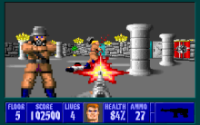By Ben Zvan
On October 07, 2008 at 09:31
General News
For the first entry, we have Sinfest with a bit of commentary on the current financial situation:
Next up is Gizmodo, with some enlightening information about voters who want deeper broadband penetration.
And finally, for now, is BBC News with a horrifying article about the current wave of mass extinction. -via Greg Laden
By Ben Zvan
On October 06, 2008 at 13:37
Photography
As an assignment for my art history class, I wrote some comments about this photograph hanging at the MIA.
 At first glance the familiar, approximately 8 x 10, size of this photograph is quite disarming. Aside from the sepia coloring of the black and white image, there is little to indicate that this is not a modern photograph of the American west. However, upon closer inspection, the smooth, glass-like, almost foggy quality of the water gives away the length of time necessary to expose a negative in 1871. While it is likely that O’Sullivan used a very large aperture during this long exposure, the depth of field reaches from the extremely close foreground nearly to infinity, enhancing the modern appearance of the image.
At first glance the familiar, approximately 8 x 10, size of this photograph is quite disarming. Aside from the sepia coloring of the black and white image, there is little to indicate that this is not a modern photograph of the American west. However, upon closer inspection, the smooth, glass-like, almost foggy quality of the water gives away the length of time necessary to expose a negative in 1871. While it is likely that O’Sullivan used a very large aperture during this long exposure, the depth of field reaches from the extremely close foreground nearly to infinity, enhancing the modern appearance of the image.
The mountainous walls of the canyon are impressively rendered as the high angle of sunlight on the stone brings out the ruggedness of the landscape. Even though the image is a classic example of landscape photography, that high angle of light brings out a definition of shape that gives the image the appearance of an intentionally lit portrait. The impression is great enough that the eye searches the walls of rocks for faces, like scanning a crowd.
The inclusion of the boat and figure near the center of the photograph gives the image a portrait-like quality as well. If the viewer didn’t already know that the picture is part of a documentary project commissioned by the war department, he could easily believe it to be a travel photograph taken to commemorate a family expedition. The inclusion of the bow of the photographer’s own boat and footprints reinforce the impression that this is not staged, but a recording of an event as it takes place.
The searching for faces also leads the viewer to an object that continually draws my attention. In the lower-left corner is a shape, like a lower-case “e” made by something unidentifiable. Possibly, this is something that a veteran wilderness explorer would recognize instantly. Possibly, it is an artifact of this particular technician’s albumen printing process. It leaves a question in the viewer’s mind about the reasoning or lack thereof behind including this shape in the final print.
Originally taken as documentation of The United States’ western expansion in the late 1800s, the photograph may have been intended to show the rough, untamed nature of the landscape that Americans had yet to conquer. In this regard, it is successful as the figure and boat give a sense of the sheer volume of stone above the river and indicates that the location would be impossible to access by any other means. The image is successful in other ways as well. The landscape was not only untamed wilderness, but a majestic scene that would be visited by millions of people in the century to come.
At the same time, the image seems devoid of opinion of its purpose. Is it intended to show the nation that there are lands out west available for the taking? That it was the manifest destiny of the nation to expand into these lands? Or is it intended to warn Americans of what dangers lay in the years and lands ahead? Without the context of caption and American history, the viewer would see this as a dynamic, technically-well-executed landscape photograph. We have seen so many thousands of photographs similar to this one that we no longer think immediately of the relationship of man to nature. We no longer consider the power inherent in ownership of this land or the power the land might bestow upon us.
The wide angle of the image, including nearly the feet of the photographer and reaching into the sky above the far bluff, still can’t include the peaks of the near cliff faces. The stone itself forms the edge of the image through its interaction with the sides and top of the print and the path of the river defines the bottom boundary of the photograph. That simple fact gives the viewer a feeling of smallness, even when the valley is represented on such a small scale.
While the primary subjects of the image, the stone walls of the canyon and the figure standing near the center are motionless by necessity of the technology of the era, the composition and framing produced many diagonal lines, many of which appear to converge off the left edge of the frame, giving the impression of motion and a feeling of more to be seen farther down the river bend. Invoking a feeling of peace in an environment of danger, the wide beach and the flowing water contrast with the apparent heat of the desert canyon, inviting the viewer, or perhaps the photographer, to stop and rest for a while.
I don't know about you, but I'm watching the smackdown tonight.
While Biden, who has been in the US senate since 1972, has to beware of his tendency to lapse into confusing verbosity, the event is being seen as particularly critical for Palin, the Alaska governor, whose knowledge of national and global issues has come under question in recent days.
"Come under question in recent days"... Yeah, that about sums it up.
 Last week, I had a hard drive die. In the past, this has been an earth-shattering event.
Last week, I had a hard drive die. In the past, this has been an earth-shattering event.
When I bought my new computer last spring, I made three major hardware decisions. The first was to get the most future-proof, powerful machine I could afford. The second was to equip it with RAID. The third was to invest in multiple, external drives for incremental backups made by Apple's Time Machine.
The first decision doesn't really come into effect here except that everything that follows the failure happened much quicker than it would have otherwise.
When a drive fails, you loose all the data stored on it, that's just the way it goes. The beauty of RAID 5 is that you can lose any one hard drive and keep all your data because it is stored redundantly. There is a very convenient function of binary math called XOR that is used by RAID 5 arrays. Basically, if you XOR all the bits in the same spot on each drive together, you get 1 (or is it zero? I can never remember.) So if one drive dies, you know that the bit stored in that spot on the drive is whatever results in 1 with an XOR opperation. As a result, when my drive failed I got a notice from the RAID controller that I was down one drive, but everything was otherwise pretty okay.
At some point, I rebooted my machine, I don't remember why. When it came back up, the RAID controller no longer seemed to think that drive was back. "Great," I thought "I'll just throw it back in the group and rebuild it." In the mean time, I was copying data between two remote web servers, and installing Parallels Desktop to make it easier to take a class from home next week. As it turns out, the current version of Parallels for Mac is not compatible with something on my machine and caused a kernel panic. That's like the Blue Screen of Death, but for Macs. You almost never see them... really.
Rebooting again, I found that my RAID controller no longer felt that it had a valid array, and that the one bad drive was preventing my machine from booting at all. Once I removed the bad drive, told the RAID controller to create a new array, and created a new filesystem on the remaining three drives. I used the Mac OS install disk to restore my system from my last known good backup on the external drive.
The moral of the story was best summed up by my friend Rick: If you're paranoid, you only have to be right once to make it worthwhile. If you always assume the best, then you have to be right every time. Two bad failures in a row + zero data loss = a happy Ben.
 It has come to my attention, reading Pharyngula, that the nation has a new reason to be upset about the current economic situation. Hundreds of thousands of people are going to lose their homes because of predatory lending practices by bankers out for a quick buck. President Bush's crack financial team has decided to give these unscrupulous bankers a hot cash injection to keep them in the market to lend while bailing out the people who probably don't need help, leaving the original hundreds of thousands of future former homeowners without the homes they probably shouldn't have been allowed to buy in the first place.
It has come to my attention, reading Pharyngula, that the nation has a new reason to be upset about the current economic situation. Hundreds of thousands of people are going to lose their homes because of predatory lending practices by bankers out for a quick buck. President Bush's crack financial team has decided to give these unscrupulous bankers a hot cash injection to keep them in the market to lend while bailing out the people who probably don't need help, leaving the original hundreds of thousands of future former homeowners without the homes they probably shouldn't have been allowed to buy in the first place.
As a result, Barack Obama has chosen to cut his losses and get out of dodge before things start to really go south.
In the wake of an epic financial meltdown that threatens to derail the U.S. economy for years, Barack Obama announced he was ending his run for President of the United States, declaring to a stunned nation, “Man, this is bullshit.”
In addition to returning all his campaign donor's money, he will be providing discount coupons on qualifying flights to Canada.
 There's a car ad, I think it's for Acura, where a guy is running down a trail through the woods when he sees a divergent path going straight up the hill, he takes it. Initially, I thought they were trying to show the runner as a risk-taking maverick character, a hardcore runner going for the challenge. That would have made a great ad for outdoor gear. The end of the commercial shows the runner reaching his car and talks about how buying a "pre-owned" vehicle is a great shortcut to getting what you "deserve."
There's a car ad, I think it's for Acura, where a guy is running down a trail through the woods when he sees a divergent path going straight up the hill, he takes it. Initially, I thought they were trying to show the runner as a risk-taking maverick character, a hardcore runner going for the challenge. That would have made a great ad for outdoor gear. The end of the commercial shows the runner reaching his car and talks about how buying a "pre-owned" vehicle is a great shortcut to getting what you "deserve."
Okay, fine, I get the buy-used line, but the guy is skimping on his morning run so he can get back to his car faster? He's probably just going to work now in order to pay off his car loan anyway. I'd rather stay outside for a while longer.
Earlier this summer, I saw a guy taking a shortcut to get to the running trail. You read that right. He was coming out of what I assume was his back yard, hopping a fence, crossing active railroad tracks, then hopping another fence to get to his run. To add silliness to potential injury, there's a road not 100 meters from his fence-jumping spot that crosses said tracks and trail.
Every time I see something like this, it really confuses me. The point of exercise is to get out and expend energy. You want to do more work in order to burn calories and fat and cause new calories and fat to be stored as muscle rather than fat reserves. Taking a shortcut can only short-circuit the whole concept of exercise.
Each day I ride, my goal is to come back a little sooner than I did last time. I don't do it by taking shortcuts, I do it by going a little faster. A few seconds less per mile each time, a minute or two less exercise each time. As I have extra time I add a few miles to my ride and start the cycle over again. A few seconds less...
 The show started with Moon Maan. They're okay, but not my kind of thing. Sounds like a typical alt-rock group where most of the songs sound pretty much the same as the rest.
The show started with Moon Maan. They're okay, but not my kind of thing. Sounds like a typical alt-rock group where most of the songs sound pretty much the same as the rest.
If I learned one thing from the show, it's that TMBG's music appeals to a broad demographic. While I didn't hear any grumbles from the crowd about blatantly liberal statements made by John, the age range was extremely wide. Many fans were my age (30s) but many had black Xs on their hands indicating they were under 21. I even ran into a Junior from my drawing class this summer who was introduced to them via Gigantic (A Tale of Two Johns) (2002).
 If I learned two things from the show, it's that I haven't really been keeping up with the band. I have the original stand-bys like Lincoln and They Might Be Giants and I love listening to them, but I don't have any of the new stuff. I guess, when I heard they were starting to do children's music, it didn't occur to me that I was missing 15 years of TMBG history already. Now I need to check out the rest of their catalog and see if there's anything I need to pick up.
If I learned two things from the show, it's that I haven't really been keeping up with the band. I have the original stand-bys like Lincoln and They Might Be Giants and I love listening to them, but I don't have any of the new stuff. I guess, when I heard they were starting to do children's music, it didn't occur to me that I was missing 15 years of TMBG history already. Now I need to check out the rest of their catalog and see if there's anything I need to pick up.
If I learned three things from the show, it's that TMBG puts on an awesome live show. Their audience interaction is flawless, and their energy level was hard for me to keep up with. Every time I took a break from shooting (not gonna do that again), they did something I wished I had caught with the camera. Luckily, my second shooter, MK was there for me. The theme of the show was the "Second Annual Swear-a-Thon", though they only swore a couple of times and slightly sheepishly at that. They made it a goal to play at least one song from every album, which meant we all got to see how good they are at making children's music that parents will like too. I'd recommend them if you're getting tired of listening to Barney every time you get into the car.
The theme of the show was the "Second Annual Swear-a-Thon", though they only swore a couple of times and slightly sheepishly at that. They made it a goal to play at least one song from every album, which meant we all got to see how good they are at making children's music that parents will like too. I'd recommend them if you're getting tired of listening to Barney every time you get into the car.
I didn't make the free, kids show on Saturday due to a conflict with a Belgian beer festival in St. Paul, but a friend made it and had many of the same things to say about them that I do. The live show was great, they kept the audience (kids this time) interested, and basically rocked out for the little ones. I suppose that might explain the wide age range present at First Avenue. The band started out in the 80s with an un-classifiable musical style that appealed to the slightly nerdy non-conformists of the era, they kept at it for 25 years and now, they're playing for the children of their original fans, keeping everyone, including the next generation, happy and involved.
I'm glad to see that TMBG has kept creative, fresh and active over their career. Unlike several concerts I've seen, this one renewed my interest in the band. I'll be keeping track of them more closely and definitely seeing their next live show.
-- Photos of They Might Be Giants by Ben Zvan Photography with help from Glimpses of Soul
Back in 2007 when John McCain was running against other Republicans for the post of Presidential Nominee, he made some statements that now cause me to doubt his faith. Not his faith in God, of which I have no doubts, but his faith in his running mate.
I am prepared. I am prepared. I need no on-the-job training. I wasn't a mayor for a short period of time. I wasn't a governor for a short period of time.For 20-some years, including leading the largest squadron in the United States Navy, I led. I didn't manage for profit. I led for patriotism.
This statement strongly implies that he should not trust Palin in any national security issue. And, in case you think I'm making this up, there's a video. (The Huffington Post has a slightly more in-depth article and, regardless of your opinion of their political views, it makes you think.)
I wonder what she would think about that if she were to follow this type of thing.
 When They Might Be Giants had their first show, they didn't really think their name might be considered arrogant or even that it might be applied to them. 26 years and 4 million record sales later, I don't think they could ever really have been called "giants" but they've done a respectable job for a couple guys named Jon who play accordion. The cult of TMBG continues on in many forms.
When They Might Be Giants had their first show, they didn't really think their name might be considered arrogant or even that it might be applied to them. 26 years and 4 million record sales later, I don't think they could ever really have been called "giants" but they've done a respectable job for a couple guys named Jon who play accordion. The cult of TMBG continues on in many forms.
Tomorrow night, they'll be performing a live show at First Avenue in downtown Minneapolis with Moon Maan. It's really hard to tell if it's too late to get tickets but if you're a fan and want to see them rock out live, that's the route I'd take if I were you, which I'm not. Obviously.
If you have kids and can't get a sitter for a Friday night, then I've got a bit of trivia you won't get from Ticketmaster. Head to Highland Lake Park in Bloomington for a free show at Target Children's Book Festival. It should be much more kid-friendly than a black-painted, dimly lit, loud nightclub with a very high bar-to-audience ratio.
I plan on having a post with photos from the First Ave show early next week.
 My class this fall is Art History 5925, The History of Photography as art. I've only attended two class sessions (I had training last week and missed the first two) but I am finding it to be a fascinating discussion of how artists and art historians have viewed photography since it's invention by Daguerre and Talbot nearly 170 years ago. I'm sure that I'll go into more detail on that later.
My class this fall is Art History 5925, The History of Photography as art. I've only attended two class sessions (I had training last week and missed the first two) but I am finding it to be a fascinating discussion of how artists and art historians have viewed photography since it's invention by Daguerre and Talbot nearly 170 years ago. I'm sure that I'll go into more detail on that later.
Years ago, when I worked at the local Renaissance Festival, I met a fellow by the name of Corvus. He was a brilliant actor, creative bloody marry maker, and aspiring game developer. I have recently developed a craving for his Holy Bloody Mary, Mother of God and asked him about his recipe, which he happily relinquished in exchange for my Perfect Margarita recipe. Once I manage to find the agave nectar he recommended, the perfect margaritas will be even more perfecter.
My new found experience with historical views on photography has probably made me more aware of how other people view art and creations. When I discovered via Facebook that Corvus had written a blog post on the history of the first-person camera in video games, I dug into it like one of my historical photographic essays. It's an interesting investigation of what most people would consider mundane truths. Have you ever been playing a video game and thought "I don't feel properly informed of my physical presence?" I will now.
Comics
AppleGeeks
The Awkward Yeti
Chainsawsuit [new!]
Ctrl+Alt+Del
Doghousediaries
Doonesbury
Formal Sweatpants
FoxTrot
Happle Tea [new!]
Hyperbole and a Half
Indexed
Joy of Tech
Kate or Die!
Lunarbaboon
Our Valued Customers
RealLife
Romantically Apocalyptic
Saturday Morning Breakfast Cereal
Scenes From A Multiverse [new!]
A Softer World
Sci-ence
Sinfest
Three Panel Soul
Wondermark
XKCD
Blogs
Almost Diamonds Antihero As I See It Black and WTF Caerwyn Farm and Spirits The Catty Life Domestic Sluttery Engrish For Goodness Sake Gizmodo Greg Laden Le Zèbre Bleu Lefse and Kimchee Lifehacker Light-test Linux in Exile Man Bytes Blog Photography is Not a Crime Post Secret Photoshop Disasters
Arts
New Pictures 8: Sarah Jones
Minneapolis Institue of Arts
04/18/2013—02/02/2014 - Free
31 Years: Gifts from Martin Weinstein
Minneapolis Institue of Arts
11/02/2013—08/31/2014 - Free
New Pictures 9: Rinko Kawauchi
Minneapolis Institue of Arts
02/20/2014—08/10/2014 - Free
Finland: Designed Environments
Minneapolis Institue of Arts
05/10/2014—08/17/2014 - Free
Music
Nick Cave and the Bad Seeds
at State Theatre
06/21/2014 \ Doors 8:00pm
Please wait while my tweets load


